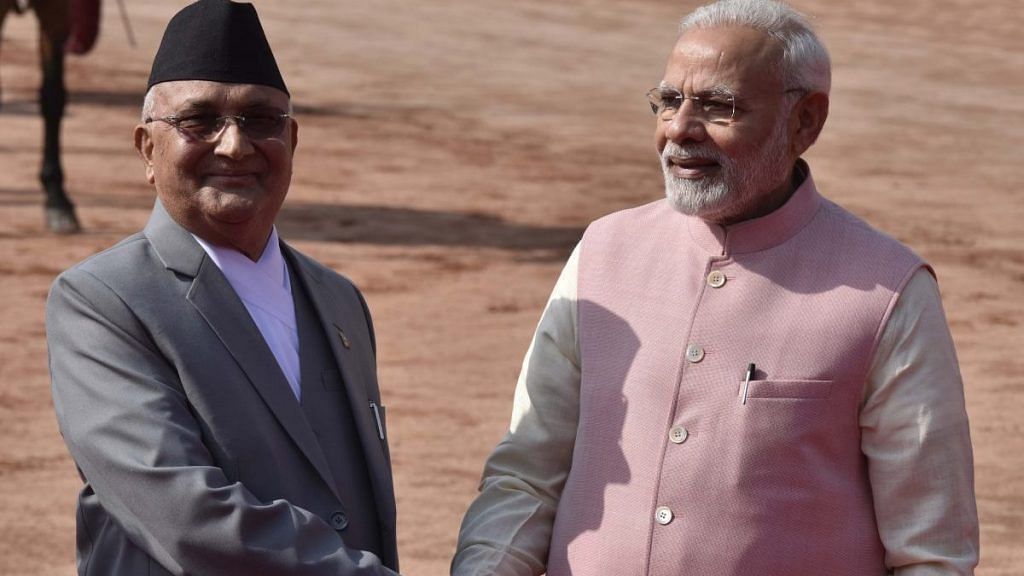It would be naïve for India to assume that China is seriously interested in a relatively small economy of Nepal.
Close on the heels of Nepal agreeing to participate in China’s One Belt One Road projects, the two nations have finalised the details of the much-awaited Protocol of Nepal-China Transit and Transport agreement.
In a major breakthrough during the third senior official-level meeting held in Kathmandu from 4-6 September, China agreed to let Nepal use Tianjin, Shenzhen, Lianyungang and Zhanjiang open seaports and Lanzhou, Lhasa and Xigatse dry ports for trading with third countries.
The protocol agreement, first conceptualised in 2016, is believed to have been suggested by Beijing to Kathmandu in the background of strong anti-India sentiments following the 2015 economic blockade. While the move is touted as a major step towards assisting Nepal to free it from its dependence on India for trade, it is unlikely that Nepal will benefit beyond negligible extent.
Nepal’s access to seven major Chinese ports will end India’s monopoly over the Himalayan nation’s trade with the outside world, say its officials. Almost 98 per cent of Nepal’s third country trade passes through Kolkata port. During his visit to India in April, Prime Minister K.P. Oli advocated for Nepal’s partnership with China through the OBOR project and said it is in keeping with its “well-judged” national interest. Another argument in favour of tilting towards China was that “Nepal cannot afford to perennially languish in poverty and backwardness”.
Also read: As Nepal taunts India, Delhi loses another friendly neighbour
It would be naïve to assume that China is seriously interested in the relatively small economy of Nepal and hopes to benefit economically from its projects there. Even the generation of hydro-electric power is useless for Beijing because the cost of transportation and loss in transmission will nullify all return on investments.
China has been seeking an assurance from Kathmandu that it will not allow its territory to be used in any manner to facilitate the travel or activities of Tibetan freedom activists.
China is also planning massive connectivity projects along the Himalayan terrain. Around this time last year, it opened the 40.4 km strategic highway between Tibet’s Xigaze airport and Xigaze city, connecting Tibet with Nepal, as part of its One Belt One Road (OBOR) initiative. The highway can be linked with the proposed cross-border Sino-Nepali railway line and can be used for both trade and military purposes. Needless to say, New Delhi has taken a serious view of this project because such a corridor is a major threat to national security.
China’s strategic engagement with India’s immediate neighbours and countries in the extended neighbourhood is almost on predictable lines.
According to China’s state-run Xinhua news agency, Pakistan army chief General Qamar Javed Bajwa himself had assured China’s foreign minister Wang Yi last week that Pakistan army will “guarantee” the smooth progress of the CPEC projects under China’s OBOR scheme. The report quotes Wang as saying: “Pakistan military is the protector of the China-Pakistan friendship and the bilateral military relations are important part of the all-weather strategic cooperative partnership between the two countries”.
Also read: After PM Oli’s return from Beijing, Nepal thinks China is the new India
China is comfortable getting an assurance from the army in Pakistan, and not the political establishment. Given the delicate relationship between the army (formerly Royal Nepal Army) and the present Communist regime and other centrist political establishments in Kathmandu, New Delhi should exercise extreme caution and watch the changes in Nepal’s army set-up and hierarchy.
China’s mountain warfare capabilities are far superior. In fact, Beijing has agreed to train an Afghan mountain brigade. A similar arrangement with Nepal might pose severe security challenge to India, not to forget the Doklam imbroglio.
The Left parties in Nepal have a long history of pursuing a consensus politics along with the centrist Nepali Congress. In the late nineties, with the entry of Communist elements led by Baburam Bhattarai and Pushpa Kamal Dahal, popularly referred to as Prachanda, political fortunes of the parties changed and the much-maligned monarchy was also pulled into the vortex of a violent struggle. King Gyanendra took on the anti-monarchy revolt, leading the army from the front against warnings. He paid a heavy price by being thrown out and stripped of all royal privileges.
Also read: India scolds Nepal for pulling out of regional military exercises in Pune
The democracy movement that began in 1950 with the restoration of the monarchy ended with the dethroning of the very same royalty. The exit of monarchy signalled a new phase of politics and propelled the Communists to the centre-stage of politics. The present Communist government headed by Oli should not be a difficult dispensation to deal with.
Yet India-Nepal relations cannot be taken for granted. New Delhi needs to do much more than just optics and seriously implement all pending projects. It must also consider involving India’s robust private sector. Instead of taking the driver’s seat, diplomats should do nothing more than hand-holding.
The author is former editor of ‘Organiser’.
